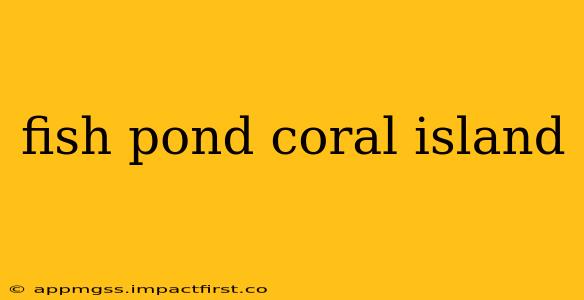Coral islands, often idyllic and seemingly abundant in marine life, face unique challenges in food security and sustainable resource management. One increasingly relevant solution gaining traction is the development of integrated fish ponds. These aren't simply holes dug in the sand; they represent a sophisticated approach to aquaculture that leverages the island environment to create a resilient and productive food source. This article explores the intricacies of fish pond development on coral islands, addressing common questions and highlighting the ecological considerations involved.
What are the benefits of fish ponds on coral islands?
Fish ponds offer several crucial advantages for coral island communities:
-
Enhanced Food Security: They provide a reliable source of protein, mitigating reliance on imported food and boosting nutritional intake. This is especially vital in remote locations with limited access to external markets.
-
Economic Opportunities: Fish farming can create income streams through the sale of surplus fish, contributing to the local economy and improving livelihoods. This can involve both local consumption and potentially small-scale export depending on the scale of operations.
-
Reduced Pressure on Reef Ecosystems: By providing a farmed alternative, fish ponds lessen the pressure on wild fish stocks, helping protect the delicate coral reef ecosystems which are often the foundation of island economies and biodiversity. Overfishing is a significant threat to reef health, and fish ponds can offer a sustainable alternative.
-
Waste Management Integration: Well-designed fish ponds can incorporate waste management strategies. For example, organic waste from the island can be used to fertilize the pond, reducing waste and improving water quality within the pond itself.
What types of fish are suitable for fish ponds on coral islands?
The choice of fish species depends on several factors including water temperature, salinity, and available space. Species commonly suited to these environments include:
-
Tilapia: Known for their hardiness and fast growth rates, tilapia are a popular choice for aquaculture in various climates.
-
Milkfish: A traditional aquaculture species in many regions, milkfish are well-adapted to brackish water conditions often found on coral islands.
-
Seabass: Certain seabass species can thrive in carefully managed pond environments, offering a higher market value.
Careful selection is critical to ensure the chosen species are environmentally suitable and economically viable for the specific island context. Introducing non-native species needs extremely careful consideration to avoid disrupting the existing ecosystem.
What are the environmental impacts of fish ponds on coral islands?
While offering many benefits, fish ponds do carry potential environmental risks if not carefully managed:
-
Water Pollution: Uneven feeding practices or inadequate waste management can lead to nutrient runoff and water pollution, potentially harming the surrounding coral reefs.
-
Disease Transmission: Intensive fish farming increases the risk of disease outbreaks, which could spread to wild fish populations.
-
Habitat Loss: Improper siting of ponds can directly lead to habitat destruction if they encroach on vital coastal ecosystems.
How can the environmental impacts of fish ponds on coral islands be minimized?
Mitigation of negative impacts requires a proactive, integrated approach:
-
Careful Site Selection: Ponds should be located away from sensitive ecosystems like mangroves and coral reefs. Hydrological studies are crucial to understanding water flow and potential impacts.
-
Sustainable Feeding Practices: Using appropriate feed quantities and types minimizes waste and reduces nutrient pollution.
-
Integrated Multi-Trophic Aquaculture (IMTA): IMTA involves cultivating multiple species together, using the waste products of one species to benefit another. This can significantly improve efficiency and reduce environmental impact. Seaweed cultivation, for example, can absorb excess nutrients.
-
Regular Water Quality Monitoring: Consistent monitoring ensures early detection of any problems, allowing for timely intervention.
-
Community Engagement: Involving local communities in planning and management ensures sustainability and buy-in, crucial for long-term success.
What are the challenges of building fish ponds on coral islands?
Building and maintaining fish ponds on coral islands presents unique challenges:
-
Limited Land Availability: Coral islands are often small and have limited space suitable for aquaculture development.
-
Fragile Ecosystems: Coral island ecosystems are highly vulnerable to disturbance, necessitating careful planning and management to prevent damage.
-
Access to Resources and Technology: Remote locations might face difficulties accessing essential materials, equipment, and expertise.
-
Climate Change Impacts: Rising sea levels and increasingly intense weather events pose threats to pond infrastructure and fish stocks.
By carefully addressing these challenges and adopting sustainable practices, fish ponds can become a valuable component of a resilient and food-secure future for coral island communities. The success of such projects hinges on a collaborative effort combining scientific knowledge, technological innovation, and community engagement.
